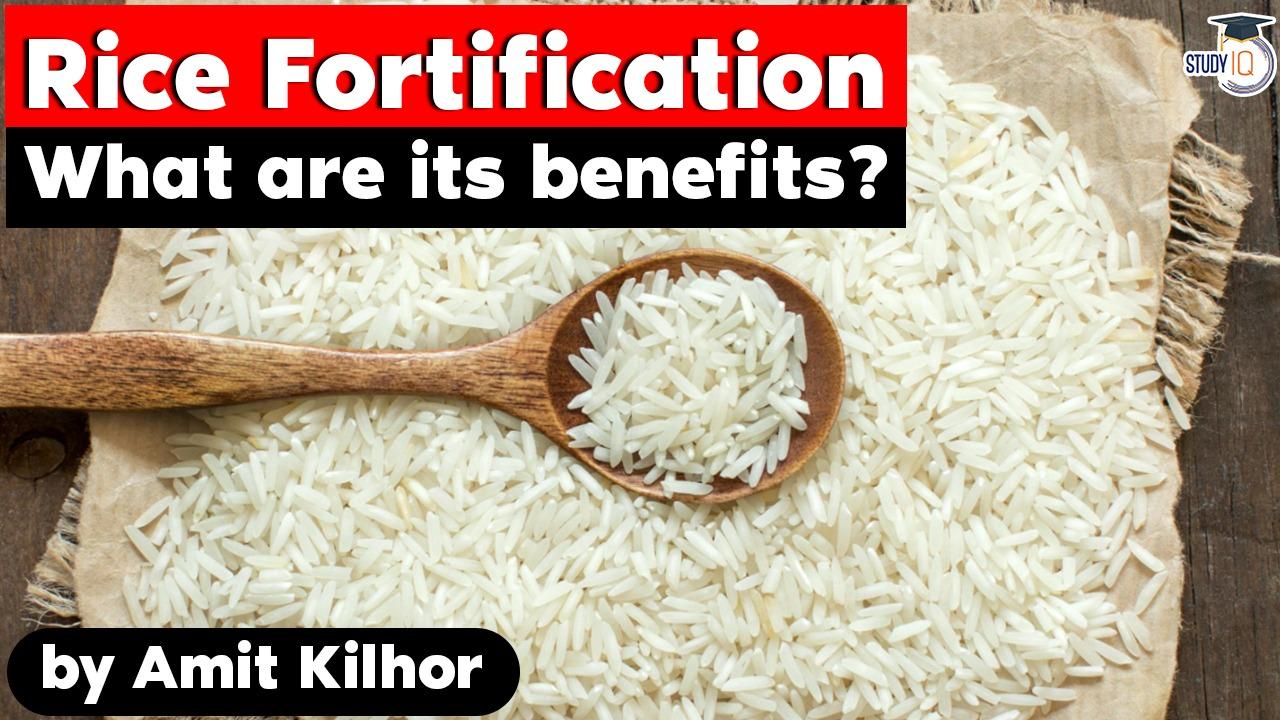Table of Contents
Rice fortification
- Rice is widely consumed in many developing countries, where ‘hidden hunger’ is an issue. This offers a unique opportunity for nutrition improvement in the form of rice fortification.
- As one of the world’s most widely consumed foods, rice plays a significant role in many diets around the globe. In low income countries, it can make up to 70% of an individual’s calorie intake. Though it is a great source of energy, it is a poor source of micronutrients and has a low overall nutritional value beyond carbohydrates and protein
- The popularity of rice presents an opportunity to fill the nutrient gap in rice-eating populations worldwide by increasing the nutritional value of rice. A wide variety of vitamins, minerals and other nutrients such as amino acids and fibers can be added post-harvest to effectively address malnutrition and contribute to Sustainable Development.
- A growing number of countries have mandated rice fortification and are fortifying rice distributed through social safety nets (for example school feeding), or have set voluntary rice fortification standards to address hidden hunger.
- Prime Minister Narendra Modi announced the fortification of rice distributed under various government schemes, including the public distribution system (PDS) and midday meals in schools, by 2024.

- What is rice fortification?
- The Food Safety and Standards Authority of India (FSSAI) defines fortification as “deliberately increasing the content of essential micronutrients in a food so as to improve the nutritional quality of food and to provide public health benefit with minimal risk to health”.
- In other words, rice fortification is a process of adding micronutrients to regular rice. The micronutrients are added keeping in mind dietary requirements.

- Various technologies are available for rice fortification, such as coating and dusting.
- For rice fortification in India, ‘extrusion’ is considered to be the best technology. This involves the production of fortified rice kernels (FRKs) from a mixture using an extruder machine.
- The fortified rice kernels are then blended with regular rice to produce fortified rice.

- There are different methods to make rice more nutritious post-harvest:
- Dusting – this is where rice kernels are dusted with a micronutrient powder, relying on an electrostatic force to bind the dry powder to the surface of the grain. Fortified rice produced by dusting cannot be washed or cooked in excess of water.
- Coating – a method that involves the use of a fortificant mix and ingredients such as wax or gum to ‘fix’ the micronutrient layer being sprayed onto rice. The produced fortified kernels are blended with regular rice, typically at 0.5 – 2% ratio.
- Hot or warm extrusion – hot extrusion is considered the most robust method of rice fortification, supported by extensive evidence base to have a positive impact on micronutrient deficiencies. Broken rice grains are ground into rice flour, then mixed with water and the required nutrients to produce a dough. The fortified dough is then passed through an extruder to produce the fortified kernels, which are then blended with regular rice typically at 0.5-2% ratio.
- In extrusion technology, dry rice flour is mixed with a premix of micronutrients, and water is added to this mixture. This mixture then goes into a twin-screw extruder with heating zones, which produces kernels similar in shape and size to rice. These kernels are dried, cooled and packaged for use. FRK has a shelf life of at least 12 months.

- As per guidelines issued by the Ministry of Consumer Affairs, Food and Public Distribution, the shape and size of the fortified rice kernel should “resemble the normal milled rice as closely as possible”. According to the guidelines, the length and breadth of the grain should be 5 mm and 2.2 mm respectively.
- Under the Ministry’s guidelines, 10 g of FRK must be blended with 1 kg of regular rice.
- According to FSSAI norms, 1 kg of fortified rice will contain the following: iron (28 mg-42.5 mg), folic acid (75-125 microgram), and vitamin B-12 (0.75-1.25 microgram). Rice may also be fortified with zinc (10 mg-15 mg), vitamin A (500-750 microgram RE), vitamin B-1 (1 mg-1.5 mg), vitamin B-2 (1.25 mg-1.75 mg), vitamin B-3 (12.5 mg-20 mg) and vitamin B-6 (1.5 mg-2.5 mg) per kg.
- The cooking of fortified rice does not require any special procedure. The rice needs to be cleaned and washed in the normal way before cooking. After cooking, fortified rice retains the same physical properties and micronutrient levels as it had before cooking.
- The Ministry estimates that the cost of producing FRK with three micronutrients — iron, folic acid, and vitamin B-12 — will come to around Rs 0.60 per kg. This cost will be shared by the Centre and the states. The government will pay this cost to rice millers.
- Fortified rice will be packed in jute bags with the logo (‘+F’) and the line “Fortified with Iron, Folic Acid, and Vitamin B12” mandatorily printed on the pack.
- seven countries have mandated rice fortification — the United States, Panama, Costa Rica, Nicaragua, Papua New Guinea, Philippines, and the Solomon Islands.
Latest Burning Issues | Free PDF






















 WhatsApp
WhatsApp